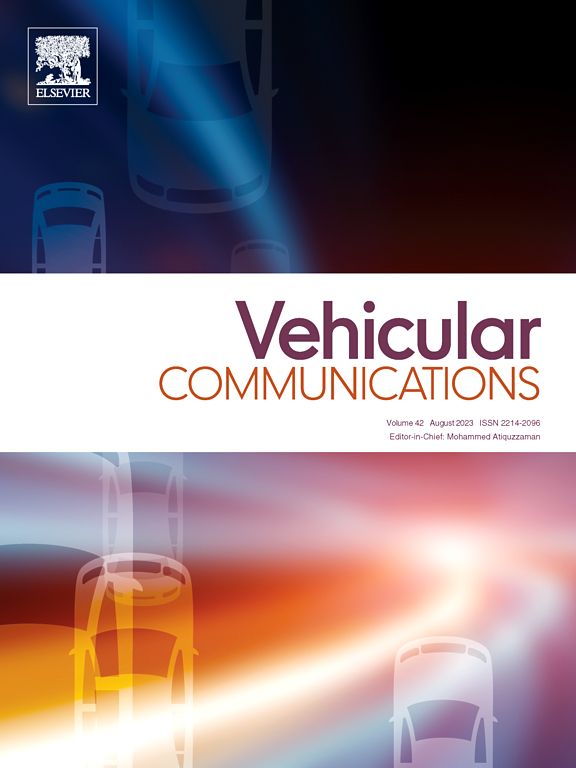一种结合深度学习和偏选的车载通信毫米波波束形成的新型分布式架构
IF 6.5
2区 计算机科学
Q1 TELECOMMUNICATIONS
引用次数: 0
摘要
车辆到基础设施(V2I)连接一直依赖于专用短程通信(DSRC)和最近的蜂窝车辆到一切(C-V2X)。然而,由于部署成本高,DSRC的采用已经放缓,而C-V2X仅限于5.9 GHz以下6 GHz频段,提供适度的数据速率,主要适用于安全关键信息。新兴的V2I服务,如高分辨率传感器共享和协同感知,需要多千兆吞吐量来在车辆和移动边缘计算(MEC)服务器之间传输大量数据(4-10 GB),这一需求超过了6 GHz以下技术的容量。本研究探索了一种新的分布式架构,利用联邦学习范式来优化V2I通信系统中的毫米波波束形成过程。通过利用多个非射频模态传感器(GPS和LiDAR)和深度学习模型,该方法旨在增强全局模型的适应性,并减少6 GHz以下信道的使用。该系统使用客户端偏向选择策略,包括MaxLoss和启发式多臂班迪(Heuristic Multi-Arm Bandit),来训练和更新全局模型,在收敛速度和整体性能方面有显著改善。使用Infocom FLASH数据集的仿真结果验证了该框架的效率,突出了其在动态环境中实际部署的潜力。本文章由计算机程序翻译,如有差异,请以英文原文为准。
A novel distributed architecture incorporating deep learning and biased selection for vehicular communication mmWaves beamforming
Vehicle to Infrastructure (V2I) connectivity has historically relied on Dedicated Short Range Communication (DSRC) and more recently Cellular Vehicle to Everything (C-V2X). However, DSRC adoption has slowed due to high deployment costs, whereas C-V2X, limited to the 5.9 GHz sub 6 GHz band, provides modest data rates mainly suitable for safety critical messages. Emerging V2I services, such as high resolution sensor sharing and cooperative perception, demand multi gigabit throughput to transfer large volumes of data (4–10 GB) between vehicles and Mobile Edge Computing (MEC) servers, requirements exceeding the capacity of sub-6 GHz technologies. This study explores a novel distributed architecture utilizing a federated learning paradigm for optimizing mmWave beamforming processes in V2I communication systems. By leveraging multiple non-RF modality sensors (GPS and LiDAR) and deep learning models, this approach aims to enhance the global model's adaptability and reduce the sub-6 GHz channel usage. The proposed system uses client-biased selection strategies, including MaxLoss and Heuristic Multi-Arm Bandit, to train and update the global model, demonstrating significant improvements in convergence rates and overall performance. Simulation results using the Infocom FLASH dataset validate the framework's efficiency, highlighting its potential for real-world deployment in dynamic environments.
求助全文
通过发布文献求助,成功后即可免费获取论文全文。
去求助
来源期刊

Vehicular Communications
Engineering-Electrical and Electronic Engineering
CiteScore
12.70
自引率
10.40%
发文量
88
审稿时长
62 days
期刊介绍:
Vehicular communications is a growing area of communications between vehicles and including roadside communication infrastructure. Advances in wireless communications are making possible sharing of information through real time communications between vehicles and infrastructure. This has led to applications to increase safety of vehicles and communication between passengers and the Internet. Standardization efforts on vehicular communication are also underway to make vehicular transportation safer, greener and easier.
The aim of the journal is to publish high quality peer–reviewed papers in the area of vehicular communications. The scope encompasses all types of communications involving vehicles, including vehicle–to–vehicle and vehicle–to–infrastructure. The scope includes (but not limited to) the following topics related to vehicular communications:
Vehicle to vehicle and vehicle to infrastructure communications
Channel modelling, modulating and coding
Congestion Control and scalability issues
Protocol design, testing and verification
Routing in vehicular networks
Security issues and countermeasures
Deployment and field testing
Reducing energy consumption and enhancing safety of vehicles
Wireless in–car networks
Data collection and dissemination methods
Mobility and handover issues
Safety and driver assistance applications
UAV
Underwater communications
Autonomous cooperative driving
Social networks
Internet of vehicles
Standardization of protocols.
 求助内容:
求助内容: 应助结果提醒方式:
应助结果提醒方式:


